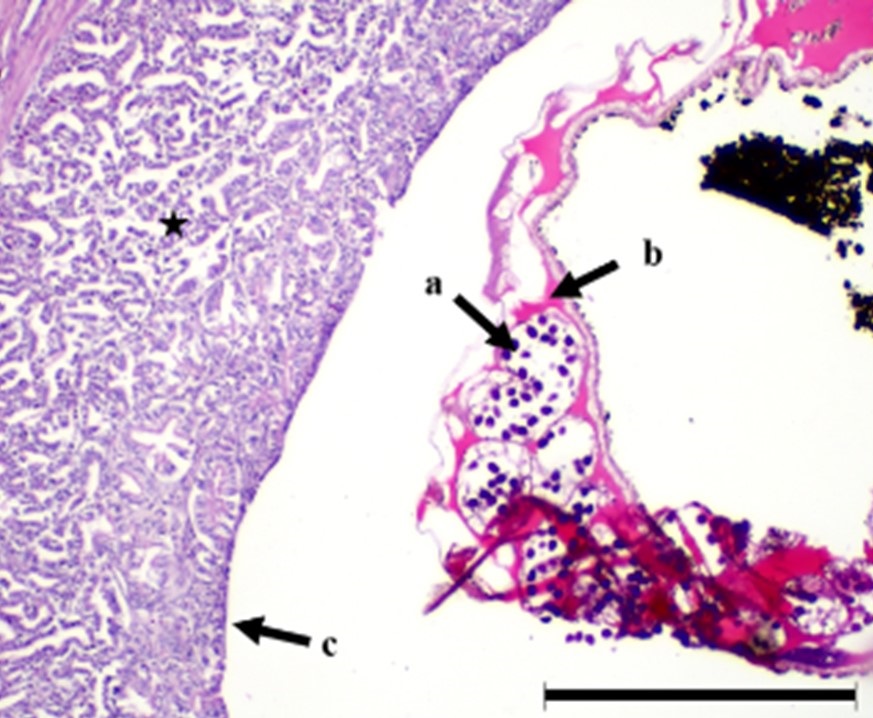Pathology of proventricular tetrameriasis in a free-range chicken
Abstract
This case report aimed to investigate the aetiology of proventricular lesions and associated clinical symptoms in local free-range chickens suspected of having proventricular tetrameriasis. Proventricular tetrameriasis is a poultry disease caused by the nematode Tetrameres sp. In this case, 15 local free-range chickens, approximately eight months old, from Gianyar, Bali, Indonesia, exhibited symptoms of anorexia and greenish diarrhoea, resulting in the death of three chickens. One of the deceased chickens underwent thorough examinations, including anatomical pathology (PA), histopathology (HP), hemagglutinin (HA), and hemagglutinin inhibition (HI) tests for Newcastle disease virus (NDV). PA examination revealed blackish and reddish nodules on the proventriculus surface, although both HA and HI tests for NDV returned negative results. HP examination of the proventriculus tissue revealed cross-sections of Tetrameres sp. nematodes with pseudo-coeloms filled with bright eosinophilic fluids. Additionally, ectasia of the proventricular glands, with compression atrophy and mild inflammation, was observed.
Downloads
References
Chandra M, Apsari IAP, Sulabda IN. 2017. Prevalensi dan Intensitas Infeksi Cacing Tetrameres spp. pada Ayam Buras di Wilayah Bukit Jimbaran, Badung. Indonesia Medicus Veterinus. 6(4):296-303.
Fink M, Permin A, Magwisha HB, Jensen KM. 2005. Prevalence of the proventricular nematode Tetrameres americana Cram (1927) in different age groups of chickens in the Morogoro region, Tanzania. Tropical Animal Health and Production. 37:133-137. https://doi.org/10.1023/B:TROP.0000048512.83379.0e | PMid:15742868
Gao JF, Mao RF, Li Y, Sun YY, Gao ZY, Zhang XG, Jin ZH, An Q, Zhang ZH, Zhang AH, Wei W, Lan Z, Wang CR. 2022. Characterisation of the mitochondrial genome of Tetrameres grusi and insights into the phylogeny of Spirurina. International Journal for Parasitology: Parasites and Wildlife. 17:35-42. https://doi.org/10.1016/j.ijppaw.2021.12.001 | PMid:34976723 PMCid:PMC8688868
Govindan VP, Annamalai L. 2019. Tetrameres sp. (Spiruridae) from Backyard Chicken (Galliformes: Phasianidae) in Puducherry - A First Report. Environmental Contaminants Reviews (ECR). 2(2): 15-16. https://doi.org/10.26480/ecr.02.2019.15.16
Kamani J, Meseko CA, Oladokun AT, Tafarki AE, Abba I, Dogo GI. 2010. Tetrameres infection in local poultry in Katsina State, Nigeria. Veterinary World. 3(3):130-132.
Kamil SA, Darzi MM, Mir MS, Shah SA, Shah SN, Khan FA. 2011. Tetrameres fissispina infection in ducks from Bandipora area of Kashmir valley. Israel Journal of Veterinary Medicine. 66(2):43-47.
Megha KG, Devi SS, Dhanush KB, Divya C, Rahmaan SB, Sajitha IS, Bindu L. 2022. Parasitic proventriculitis associated with Tetrameres spp. infection in ducks. Veterinary Practitioner. 23(1):85-87.
Taylor MA, Coop RL, Wall RL. 2016. Veterinary Parasitology. 4th ed. Wiley Blackwell. UK. https://doi.org/10.1002/9781119073680
Yulianda Y, Dwinata IM, Winaya IBO. 2023. Prevalensi dan Histopatologi Proventrikulus pada Itik Bali yang Terinfeksi Cacing Tetrameres spp. di Bali. Indonesia Medicus Veterinus. 12(1):22-31. https://doi.org/10.19087/imv.2023.12.1.22

Copyright (c) 2024 CC-BY-SA

This work is licensed under a Creative Commons Attribution-ShareAlike 4.0 International License.
Authors who publish with this journal agree to the following terms:
1. Authors retain copyright and grant the journal right of first publication with the work simultaneously licensed under a Creative Commons Attribution License that allows others to share the work with an acknowledgement of the work's authorship and initial publication in this journal.
2. Authors are able to enter into separate, additional contractual arrangements for the non-exclusive distribution of the journal's published version of the work (e.g., post it to an institutional repository or publish it in a book), with an acknowledgement of its initial publication in this journal.
3. Authors are permitted and encouraged to post their work online (e.g., in institutional repositories or on their website) prior to and during the submission process, as it can lead to productive exchanges, as well as earlier and greater citation of published work (See The Effect of Open Access).

.jpg)















